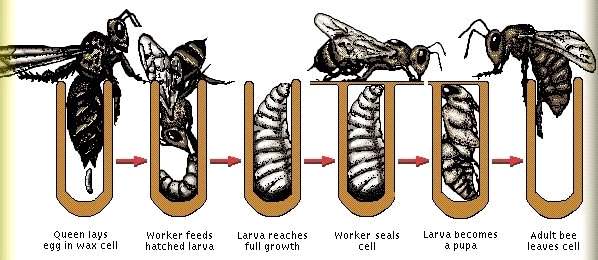Individual Life Cycles
The number of days in a bee’s developmental stage, is shown in the table below. The table shows the number of days spent as an egg, a larva and as a pupa plus the number of days taken to reach full maturity for all 3 classes of honey bee.
|
Number of Days |
|||||
|
Egg |
Larva |
Pupa |
Total Days to Adult |
Days to Maturity |
|
|
Queen |
3 |
5 |
8 |
16 |
20 |
|
Worker |
3 |
5 |
13 |
21 |
21 |
|
Drone |
3 |
8 |
13 |
24 |
34
|
Workers Division of Labour
This table shows how labour is divided by workers according to the bees developmental stage. The activities are closely linked to the development of the bee’s glands and hence a bee’s level of maturity.
|
Age (days) |
Activity |
Development of Glands |
|
0 – 6 |
Cell cleaning, general hive cleaning |
|
|
3 – 9 |
Feeding the brood |
Highly developed to produce brood food and royal jelly |
|
3 – 15 |
Attending the Queen |
|
|
6 – 18 |
Honey processing |
Glands shrink but produce enzymes |
|
12 – 20 |
Wax production & honey processing |
Wax glands |
|
15 – 25 |
Hive ventilation |
|
|
18 – 35 |
Guard duty |
Sting and nasanov glands for scent develop |
|
20 – death |
Nectar collection |
|
|
20 – death |
Pollen collection |
|
|
25 – death |
Water & propolis collection |
Reproduction and Development
The queen controls the sex of her offspring. When an egg passes from her ovary to her oviduct, the queen determines whether the egg is fertilized with sperm from the spermatheca. A fertilized egg develops into a female honeybee, either worker or queen, and an unfertilized egg becomes a male honeybee, or drone.
The queen lays the eggs that will develop into more queens in specially constructed downward-pointing, peanut-shaped cells, in which the egg adheres to the ceiling. These cells are filled with royal jelly to keep the larvae from falling and to feed them.

